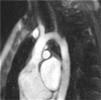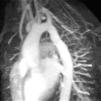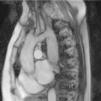Systemic hypertension at rest or during exercise persists in a significant number of patients after early repair of coarctation of the aorta (CoA). Recoarctation explains only a small percentage of these cases, and recent studies have suggested intrinsic anomalies in aortic arch geometry (“gothic arch”) as a possible cause, irrespective of whether the repair was surgical or percutaneous.1,2
We retrospectively assessed all magnetic resonance imaging (MRI) studies in a consecutive series of patients followed in our institution, analyzing the prevalence of the various types of aortic arch geometry: gothic, romanesque and crenel. All the studies were performed using a Signa 1.5T (GE Medical Systems, Milwaukee, WI, USA). Anatomical types were classified by two physicians experienced in MRI (>1500 exams between them), based on images acquired using black blood, cine or angiographic techniques.
The type of aortic arch could be classified in 59 of the 77 consecutive patients with corrected CoA. Those with recoarctation or other significant aortic arch abnormalities, such as arch hypoplasia in the context of hypoplastic left heart syndrome, were excluded. The results showed the following distribution of types: romanesque (n=22; Figure 1), gothic (n=20; Figure 2) and crenel (n=17; Figure 3), which is similar to the distribution described for international series reported in the literature.
A significant proportion of our series of patients with corrected CoA had aortic arch geometry that predisposes to hypertension at rest or during exercise. Besides screening for anatomical and physiological signs of recoarctation, magnetic resonance study after aortic coarctation repair should also assess aortic arch geometry, since this has a significant impact on the management and prognosis of these patients.
Conflicts of interestThe authors have no conflicts of interest to declare.
Please cite this article as: Martins, JD. Geometria do arco aórtico em coarctações da aorta corrigidas: estudo sistemático por ressonância magnética numa série consecutiva de doentes. Rev Port Cardiol. 2012. doi:10.1016/j.repce.2012.03.006










